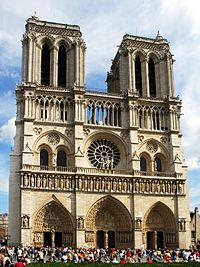
Back الرومانية الكاثوليكية في فرنسا Arabic Església catòlica a França Catalan Římskokatolická církev ve Francii Czech Römisch-katholische Kirche in Frankreich German Iglesia católica en Francia Spanish Église catholique en France French Katolička Crkva u Francuskoj Croatian Gereja Katolik di Prancis ID Chiesa cattolica in Francia Italian フランスのカトリック Japanese
Catholic Church in France | |
|---|---|
| French: Église catholique en France | |
 | |
| Type | National polity |
| Classification | Catholic |
| Scripture | Bible |
| Theology | Catholic theology |
| Governance | CEF |
| Pope | Francis |
| President | Éric de Moulins-Beaufort |
| Primate of the Gauls | Olivier de Germay[1] |
| Apostolic Nuncio | Celestino Migliore[2][3] |
| Region | France, Monaco |
| Language | French, Latin |
| Headquarters | Notre-Dame de Paris |
| Founder | Saint Remigius |
| Origin | c. 177 Christianity in Gaul c. 496 Frankish Christianity Gaul, Roman Empire |
| Separations | Huguenots (16th century) |
| Members | 27,000,000–58,000,000 |
| Official website | Episcopal Conference of France |
The French Catholic Church, or Catholic Church in France is part of the worldwide Catholic Church in communion with the Pope in Rome. Established in the 2nd century in unbroken communion with the bishop of Rome, it was sometimes called the "eldest daughter of the church" (French: fille aînée de l'Église).
The first written records of Christians in France date from the 2nd century when Irenaeus detailed the deaths of ninety-year-old bishop Saint Pothinus of Lugdunum (Lyon) and other martyrs of the 177 AD persecution in Lyon. In 496 Remigius baptized King Clovis I, who therefore converted from paganism to Catholicism. In 800, Pope Leo III crowned Charlemagne Emperor of the Holy Roman Empire, forming the political and religious foundations of Christendom in Europe and establishing in earnest the French government's long historical association with the Catholic Church.[4] In reaction, the French Revolution (1789–1799) was followed by heavy persecution of the Catholic Church. Since the beginning of the 20th century, Laïcité, absolute neutrality of the state with respect to religious doctrine, is the official policy of the French Republic.
Estimates of the proportion of Catholics in 2020 range between 47% and 88% of France's population, with the higher figure including lapsed Catholics and "Catholic atheists".[5][6] The Catholic Church in France is organised into 98 dioceses, which in 2012 were served by 7,000 sub-75 priests.[7] 80 to 90 priests are ordained every year, although the church would need eight times as many to compensate the number of priest deaths. Approximately 45,000 Catholic church buildings and chapels are spread out among 36,500 cities, towns, and villages in France, but a majority are no longer regularly used for mass. Notable churches of France include Notre Dame de Paris, Chartres Cathedral, Dijon Cathedral, Reims Cathedral, Saint-Sulpice, Paris, Basilique du Sacre-Coeur, Strasbourg Cathedral, Eglise de la Madeleine, and Amiens Cathedral. Its national shrine, Lourdes, is visited by 5 million pilgrims yearly.[8] The capital city, Paris, is a major pilgrimage site for Catholics as well.
In recent decades, France has emerged as a stronghold for the small but growing Traditionalist Catholic movement,[9] along with the United States, England and other English-speaking countries.[10][11][12] The Society of Saint Pius X, a canonically irregular priestly society founded by French Archbishop Marcel Lefebvre has a large presence in the country, as do other traditionalist priestly societies in full communion with Rome such as the Priestly Fraternity of St. Peter, Institute of Christ the King Sovereign Priest and others.[13]
Some of the most famous French saints and blesseds include St. Denis, St. Thérèse of Lisieux, St. Irenaeus, St. John Vianney (the Curé of Ars), St. Joan of Arc, St. Bernadette, St. Genevieve, Louis IX of France, St. Elizabeth of the Trinity, St. Vincent de Paul, St. Louise de Marillac, St. Catherine Labouré, St. Louis de Montfort, St. Jean-Baptiste de La Salle, St. Francis de Sales, St. Margaret Mary Alacoque, Bl. Nicholas Barré, St. Louis-Marie Grignion de Montfort and St. Bernard of Clairvaux.
- ^ "Former paratrooper is the new Archbishop of Lyon". 23 October 2020.
- ^ "Celestino Migliore, nuevo Nuncio Apostólico en Francia". Religión Digital. 11 January 2020.
- ^ "Pope appoints new envoy to France after abuse claims". www.thenews.com.pk.
- ^ "France". Berkley Center for Religion, Peace, and World Affairs. Archived from the original on 6 February 2011. Retrieved 14 December 2011. See drop-down essay on "Religion and Politics until the French Revolution"
- ^ "France – The World Factbook". www.cia.gov. 7 June 2022.
- ^ US State Dept 2022 report
- ^ "L'Église face à la pénurie des prêtres". Le Figaro. 28 June 2012.[permanent dead link]
- ^ Every pilgrim's guide to Lourdes by Sally Martin 2005 ISBN 1-85311-627-0 p. vii
- ^ "Survey finds fervor among young French Catholics". The Pillar. 26 May 2023. Retrieved 30 May 2023.
- ^ Allen, John (14 September 2008). "Pope in France: Traditionalists deserve a place in the Church". National Catholic Reporter. Retrieved 2 November 2021.
- ^ "French Catholic Bishops Express 'Esteem' for Traditional Latin Mass Communities". National Catholic Register. 19 July 2021. Retrieved 2 November 2021.
- ^ Wooden, Cindy (20 July 2021). "Traditional Latin Mass 'movement' sows division, archbishop says". National Catholic Reporter. Retrieved 2 November 2021.
- ^ Tadié, Solène. "How French Catholics are responding to Pope Francis' Traditional Latin Mass restrictions". Catholic News Agency. Retrieved 2 November 2021.